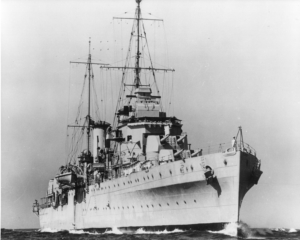All over the world, the extraordinary value of scrap metal is becoming quite painfully clear to many authorities. Criminal acts for the purposes of stealing scrap metal are skyrocketing like never before, as too is the creativity of those choosing to access and obtain scrap metal illegally. So much so that it seems some are quite happy to go to the ends of the earth – or even the bottom of the ocean – to take scrap metal that doesn’t belong to them.
 The story we picked up on earlier this week told of a team of Australian and Indonesian divers, which made the shocking discovery that an incredible 60% of a sunken WWII battleship had apparently disappeared without a trace. Or more accurately, HMAS Perth had fallen victim to illegal salvaging on the most enormous scale – all taking place on the seabed off the coast of Java.
The story we picked up on earlier this week told of a team of Australian and Indonesian divers, which made the shocking discovery that an incredible 60% of a sunken WWII battleship had apparently disappeared without a trace. Or more accurately, HMAS Perth had fallen victim to illegal salvaging on the most enormous scale – all taking place on the seabed off the coast of Java.
“This isn’t what we were hoping to find,” said Australian National Maritime Museum director Kevin Sumption.
“It is with profound regret we advise that our joint maritime archaeologist diving team has discovered sections of the Perth missing.”
Prior to the latest dive going ahead, the team had expected illegal salvaging to have had a significant impact on the ship. Nevertheless, they were shocked to find only somewhere in the region of 40% of the ship remaining. Sunk 75 years ago, HMAS Perth was one of the most important and celebrated warships in Australian history.
“While some damage is a result of the Japanese torpedo strikes that sank the vessel in 1942 and the expected degradation of the site over the last 75 years, there are signs the removal of this material is a result of salvage, with some salvage equipment visible around the site,” Mr Sumption added.
Quite a different story from the everyday scrap metal thefts that are occurring in record numbers all over the world, what makes naval shipwreck so appealing is the way in which many of the materials have exceptionally high values. For example, some of the bronze used in the manufacture of the propellers the driver the ships can be worth up to $4,000 per tonne.
As such, this is far from the only shipwreck in the region to have fallen victim to thieves over recent years and decades. The problem being that as the waters around the region are so incredibly expansive and complicated, it is fundamentally impossible to successfully police all of them.
But what makes this particular example so distressing for many experts is the way in which the HMAS Perth was intended to be designated a war grave and left alone. Given the impossibility of retrieving many of those who lost their lives when the ship was torpedoed, it was to be left alone as a mark of respect.
Unfortunately, respect doesn’t seem to have come into the equation among those who make the decision to illegally strip the ship of its valuable metals.
















